Taylor Wessing Prize 2021: Shortlisted photographers revealed
- Published

Sydney-based photographer David Prichard is shortlisted for his series of portraits of indigenous people in Australia
Themes of courage in the face of adversity, body positivity and trauma experienced by indigenous people in Australia feature on the shortlist for this year's Taylor Wessing Prize.
Photographers Katya Ilina, Pierre-Elie de Pibrac and David Prichard have all been recognised for the prestigious award, with the winner due to be announced on 8 November.
The prize showcases new work submitted by contemporary photographers. The winner of the first prize will receive £15,000. The second prize-winner receives £3,000 and the third prize £2,000.
The images, which will go on display at Cromwell Place, a new arts hub in South Kensington, were selected from submissions by 2,215 photographers from 62 countries.
The shortlisted photographs are usually exhibited in the National Portrait Gallery, but that is currently closed for major redevelopment works.
Last year's award was won by Alys Tomlinson for her series of portraits of school leavers dressed for proms that never took place due to the coronavirus pandemic.
This year's three nominated photographers are:
Katya Ilina, for the portrait David

Born in the Russian city of Perm in 1990, Katya Ilina is now studying photography at university in Toronto.
Her entry, titled David, is part of a series of portraits which celebrate positive body image and question notions of masculinity and femininity.
Discussing the series, Ilina said: "From Velázquez to Ingres, painters have portrayed men in positions of power, or as muscular heroes in battle, whereas females are often pictured naked and reclining, communicating softness, weakness and openness to gaze.
"I wanted to borrow the so-called feminine body language from those paintings and juxtapose it with male sitters. Being physically and emotionally strong still dominates Western ideologies and expectations of 'real men', but it's important that contemporary men have the right to be vulnerable and gentle, and not feel ashamed of that."
Pierre-Elie de Pibrac for the series Hakanai Sonzai






Pierre-Elie de Pibrac was born in Paris, France in 1983. He graduated from business school in 2009 but chose not to follow a career in finance when his first photographic portraits, taken on a trip to Myanmar, received immediate recognition.
Pilbrac's shortlisted series of portraits were taken in Japan, where he spent eight months accompanied by his wife and children. Travelling to the country's most troubled regions, he focused his lens on people who exhibited courage in the face of adversity.
In Fukushima, he photographed residents still exiled from their contaminated homes following the nuclear meltdown a decade ago. Other portraits were taken in the former mining town Yubari, once known as the country's capital of coal, now devastated by colliery closures and depopulation.
He explained: "Each portrait emanates from long discussions I had with my subjects about a painful event in their lives. In all the pictures I forbid any movement, as if they are trapped by their surroundings with no visible escape."
David Prichard for the series Tribute to Indigenous Stock Women




Sydney-based photographer David Prichard's entry is a series of portraits of First Nation women who spent most of their working lives as stock women on cattle stations in Far North Queensland.
Their physically demanding work involved a range of duties, from cooking and other homestead chores to maintaining the welfare of the livestock, often on horseback.
"Any level of investigation into Australian history reveals the years of trauma that indigenous people have suffered," Prichard said. "One can only imagine what stock women endured, living in remote areas, in a world dominated by white colonial culture and law. I wanted to produce portraits that were dignified, strong and beautiful, and worthy to represent these women today and into the future."

Follow us on Facebook, external, or on Twitter @BBCNewsEnts, external. If you have a story suggestion email entertainment.news@bbc.co.uk, external.
Related topics
- Published26 November 2020
